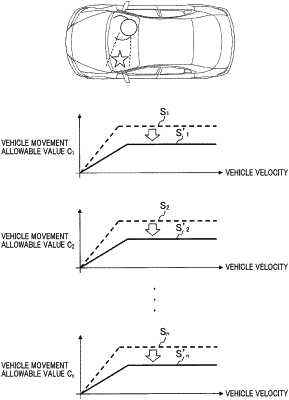| CPC B60W 60/0013 (2020.02) [B60W 40/08 (2013.01); B60W 40/10 (2013.01); G06V 20/593 (2022.01); B60W 2420/403 (2013.01); B60W 2520/125 (2013.01); B60W 2520/14 (2013.01); B60W 2540/043 (2020.02); B60W 2540/225 (2020.02); B60W 2540/227 (2020.02); B60W 2556/40 (2020.02)] | 9 Claims |

|
1. A vehicle control system which enables a vehicle to perform automatic traveling, the system comprising:
an occupant information detection unit configured to detect position information and behavior information of an occupant based on vehicle inside information;
an allowable value calculation unit configured to calculate a vehicle movement allowable value based on the position information and the behavior information which the occupant information detection unit detects;
a trajectory generation unit configured to generate trajectory information including a scheduled route and a scheduled time of traveling based on the vehicle movement allowable value calculated by the allowable value calculation unit; and
an automatic traveling control unit configured to generate a control command value transmitted to an actuator of the vehicle corresponding to the trajectory information which the trajectory generation unit generates, wherein
the occupant information detection unit is configured to acquire or detect line-of-sight information relating to a line-of-sight direction of the occupant, and is configured to estimate whether a visual recognition object of the occupant exists outside the vehicle or inside the vehicle based on the line-of-sight information, and
the allowable value calculation unit is configured to, in the case where the occupant information detection unit estimates that the visual recognition object exists inside the vehicle, make the vehicle movement allowable value small compared to a case where the occupant information detection unit estimates that the visual recognition object exists outside the vehicle,
the occupant information detection unit is configured to, in the case where the visual recognition object is a video existing inside the vehicle, detect or acquire whether the video is a still image or a moving image, and
the allowable value calculation unit is configured to, in the case where the video is the still image, make the vehicle movement allowable value small compared to the case where the video is the moving image.
|